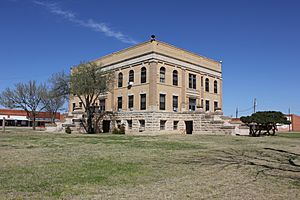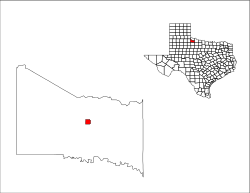Crowell, Texas facts for kids
Quick facts for kids
Crowell, Texas
|
|
|---|---|

Foard County Courthouse
|
|

Location of Crowell, Texas
|
|
 |
|
| Country | United States |
| State | Texas |
| County | Foard |
| Area | |
| • Total | 1.89 sq mi (4.89 km2) |
| • Land | 1.89 sq mi (4.88 km2) |
| • Water | 0.00 sq mi (0.00 km2) |
| Elevation | 1,476 ft (450 m) |
| Population
(2020)
|
|
| • Total | 769 |
| • Density | 406.9/sq mi (157.26/km2) |
| Time zone | UTC-6 (Central (CST)) |
| • Summer (DST) | UTC-5 (CDT) |
| ZIP code |
79227
|
| Area code(s) | 940 |
| FIPS code | 48-17948 |
| GNIS feature ID | 2410269 |
Crowell is a small city located in Foard County, Texas, in the United States. It is the main town and the county seat for Foard County. In 2020, about 769 people lived there. This number was a bit lower than the 948 people who lived there in 2010.
Contents
Where is Crowell Located?
Crowell is found right in the middle of Foard County. A major road, U.S. Route 70, goes through the city. This road is called Commerce Street in Crowell. If you go east on US 70, you'll reach Vernon in about 33 miles. Going west for 36 miles will take you to Paducah.
Another important road, Texas State Highway 6, crosses US 70 in the center of Crowell. Heading north on Highway 6 for 22 miles leads to Quanah. If you go south for 28 miles, you'll arrive in Benjamin. The larger city of Wichita Falls is about 81 miles east of Crowell.
The city covers an area of about 1.89 square miles (4.9 square kilometers). All of this area is land. Crowell is about 1,476 feet (450 meters) above sea level. The land around Crowell is mostly flat with some gentle hills. The soil is good for growing crops like wheat, cotton, and hay. The area is also used for raising beef cattle.
How Many People Live in Crowell?
The number of people living in Crowell has changed over the years. Here's a quick look at the population from different census counts:
| Historical population | |||
|---|---|---|---|
| Census | Pop. | %± | |
| 1910 | 1,341 | — | |
| 1920 | 1,175 | −12.4% | |
| 1930 | 1,946 | 65.6% | |
| 1940 | 1,817 | −6.6% | |
| 1950 | 1,912 | 5.2% | |
| 1960 | 1,703 | −10.9% | |
| 1970 | 1,399 | −17.9% | |
| 1980 | 1,509 | 7.9% | |
| 1990 | 1,230 | −18.5% | |
| 2000 | 1,141 | −7.2% | |
| 2010 | 948 | −16.9% | |
| 2020 | 769 | −18.9% | |
| U.S. Decennial Census | |||
Crowell's Population in 2020
In 2020, there were 769 people living in Crowell. These people lived in 298 households, and 169 of these were families.
The population of Crowell in 2020 was made up of different groups:
| Race | Number | Percentage |
|---|---|---|
| White (not Hispanic) | 575 | 74.77% |
| Black or African American (not Hispanic) | 12 | 1.56% |
| Asian (not Hispanic) | 2 | 0.26% |
| Pacific Islander (not Hispanic) | 1 | 0.13% |
| Other Race (not Hispanic) | 2 | 0.26% |
| Mixed/Multi-Racial (not Hispanic) | 17 | 2.21% |
| Hispanic or Latino | 160 | 20.81% |
| Total | 769 |
Crowell's History and Local Attractions
Crowell is located between two rivers: the Pease River to the north and the North Wichita River to the south. This area has always been home to many tough animals and plants. The local grasses can handle dry weather well. You can find trees like mesquite, hackberry, and pecan here. Animals like coyotes, squirrels, badgers, and foxes live in the area. In recent years, deer and wild pigs have also become common. Many types of birds, including quail and dove, are also seen. Crowell is also on the path where monarch butterflies fly during their migration.
A few miles from Crowell is a historic spot known as the Pease River battleground. This is where Cynthia Ann Parker was found by U.S. soldiers. She had been captured by Native Americans as a child. Cynthia Ann was the mother of Quanah Parker, who was a very important chief of the Comanche people.
While not many famous people come from Crowell, one person worth mentioning is Dick Todd. He was a great football player for Texas A&M University. Later, he played for and coached the Washington Redskins. An award is given each year in memory of his son, Denny, who passed away as a teenager. This award honors a football player who shows great personal effort for the team.
Because Crowell is in a quiet, rural area, there isn't much light from cities. This makes it a fantastic place to see the stars at night! That's why the Comanche Springs Astronomy Campus is located here. It's a 50-acre observatory built by the Three Rivers Foundation for the Arts and Sciences.
The main way people in Crowell make money is through farming. Raising beef cattle and growing wheat and cotton are the biggest jobs. People also earn money by leasing land for hunting. There is also a factory in Crowell that makes caps. It used to be owned by the DeLong company but is now owned by local investors.
Even though Crowell is a small town, it has interesting places to visit. Besides the observatory, there's a museum built by the Foard County Historical Society. It's in the old fire station and has many items from Crowell's past. One special exhibit is a detailed scale model of the town. It shows important businesses from the city's history. Right across the street, you can also visit the Farm Implement Museum.
Education in Crowell
Students in Crowell attend schools run by the Crowell Independent School District. The local high school team is known as the Crowell High School Wildcats.
Crowell's Climate
Crowell has a semiarid climate. This means it's usually dry, but not a desert. It gets some rain, but not a lot.
See also
 In Spanish: Crowell (Texas) para niños
In Spanish: Crowell (Texas) para niños

